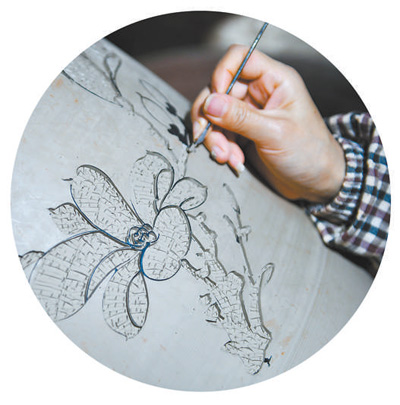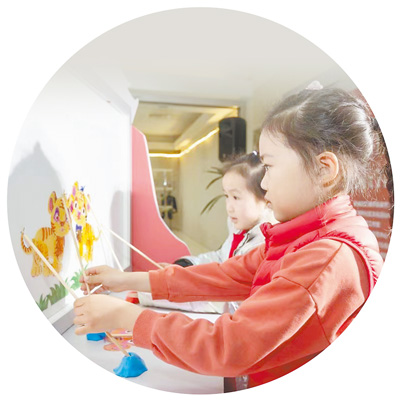 |
In the process of making purple pottery in Jianshui County, Yunnan Province, the ceramic body is carved with flowers.
Photographed by Chen Xinbo, reporter of Xinhua News Agency |
 |
Children experience shadow play in community activities.
Photographed by Wang Xiang, a reporter from Xinhua News Agency |
Core reading
Intangible cultural heritage skills have gradually returned to production practice and life experience from the past rescue protection and exhibition dissemination. Intangible cultural heritage handicrafts have entered people's daily life from museums. Intangible cultural heritage resources are organically integrated into cultural life, deeply embedded in the development of cultural industry, showing the ever-changing flavor of the times and innovative vitality.
The concept of "seeing people, seeing things, seeing life" has become a consensus in the inheritance and development of intangible cultural heritage. Let cultural heritage "live", let intangible cultural heritage skills "tide", adhere to live inheritance, intangible cultural heritage will bear fruitful results in real life.
On September 14, 2021, in the Exhibition Hall of Intangible Cultural Heritage in Suide County, Yulin, Shaanxi Province, General Secretary Xi Jinping pointed out that "folk art is the precious wealth of the Chinese nation. Protecting, inheriting and making good use of these treasures left by the old ancestors is of great significance to continue the historical context and build a socialist cultural power." Behind the colorful folk art, It is inseparable from the support of traditional skills. These traditional skills are engraved with historical marks, are the crystallization of the wisdom of the Chinese nation, and are also valuable intangible cultural heritage. In recent years, many traditional skills have regained their vitality and led the social trend. In the "Double 11" shopping festival last year, the online sales of intangible cultural heritage handicrafts soared. Dehua porcelain, Yixing purple sand, Quyang stone carving, Dongyang wood carving, Nanping Jianzhan, Yangzhou folk music, and Xuancheng four treasures of the study... Consumers competed to buy related products, vividly reflecting the contemporary vitality of intangible cultural heritage technology - "time-honored brands" are becoming "new online celebrities" favored by young people.
New forms and expressions, showing the diversified charm of traditional skills
With the development of the times, many intangible cultural heritage skills have gradually returned to production practice and life experience from the past rescue protection and exhibition style dissemination. Intangible cultural heritage handicrafts have entered the daily life of the people from museums. Intangible cultural heritage resources are organically integrated into cultural life, deeply embedded in the development of cultural industry, showing the ever-changing atmosphere of the times and innovative vitality. At present, the cross-border integration of "intangible cultural heritage+" has become an important symbol of intangible cultural heritage inheritance and innovation, which is mainly manifested in the following types.
First, "intangible cultural heritage+cultural and creative", taking intangible cultural heritage elements as the creative source of products. Liangping Bamboo Curtain Bluetooth speakers, Suzhou Kesi handbags, Hami embroidery earphones, Guangxi Zhuang brocade scarves, Quyang Dingci dolls, Chaoyang paper-cut series sports shoes... These best-selling cultural and creative products are all produced by cross-border cooperation between intangible cultural heritage inheritors and product designers. Intangible cultural heritage technology lights up the design inspiration of cultural and creative products, and modern design gives intangible cultural heritage technology a fashionable temperament. The organic integration of the two is welcomed by people.
Second, "intangible cultural heritage+cultural tourism", relying on intangible cultural heritage resources to create a unique cultural tourism brand. Xi'an's Datang Sleepless City attracts tourists from all over the world through paper-cut, clay sculpture, shadow puppets, Western Qin embroidery, Qin Opera facial makeup and other intangible cultural heritage crafts and derivatives, becoming a tourist destination for young people to "punch in"; The Yongqingfang Tourist Area in Xiguan, Guangzhou, has integrated many intangible cultural heritage fashion shows of gold embroidered skirts and gowns into the Lingnan folk "flower street", which has opened the eyes of tourists; In Qingjiang Gallery Scenic Area of Changyang Tujia Autonomous County, Yichang, tourists can personally participate in and experience intangible cultural heritage crafts such as Tujia brocade, handmade insoles, straw sandals, and immerse themselves in local customs. At present, there are more and more scenic blocks relying on the experience of intangible cultural heritage skills, which has become an important trend of integrated development of culture and tourism.
Third, "intangible cultural heritage+entertainment", more and more literary and artistic works take intangible cultural heritage skills as the performance object. Documentary films about the skills and inheritors of intangible cultural heritage continue to emerge, such as "The Great Craftsman", "Inheritance on Fingertips", "Shanghai Style Hundred Craftsmen", etc. These original niche themes, through video recording, show the process of craftsmanship in detail, and convey the spirit of craftsmanship behind exquisite craftsmanship, attracting public attention. On the short video and live broadcast platforms, some intangible cultural heritage craftsmen have set up We Media accounts to narrow the gap between intangible cultural heritage and the general public by displaying their personal works, sharing teaching videos, explaining intangible cultural heritage knowledge, etc. In recent years, the production of film and television plays has become more sophisticated in clothing, props and scenes. The "Ronghua" in Yanxi Strategies, the "Shu Brocade" in Tiansheng Changge, the "Bamboo Lantern" in Chang'an Twelve Hours, the "Bianjing Song Room Kite" in Qingping Music, etc. These traditional handcrafts permeate the details of film and television dramas, not only creating the historical texture of the works, but also letting the audience appreciate the beauty of traditional culture.
The dynamic "intangible cultural heritage+" phenomenon shows that contemporary consumers' preference for intangible cultural heritage skills is not only due to the use value of related products, but also due to the rich historical connotation and unique cultural identity behind the material. The aesthetics of life and cultural memory conveyed by intangible cultural heritage crafts rekindle the years, refresh the time, and convey the real temperature of traditional culture in the connection between the past and the present. Especially from the perspective of globalization, the intangible cultural heritage skills that condense Chinese people's ideological wisdom, aesthetic experience and emotional identity can make the world intuitively understand Chinese history and vividly understand Chinese culture. Inheriting and developing intangible cultural heritage skills has a unique role in telling Chinese stories, highlighting Chinese aesthetic interests, and promoting cultural exchanges and mutual learning.
Industrialization and activation to stimulate the contemporary vitality of intangible cultural heritage resources
The art of intangible cultural heritage can set off a boom, which not only reflects the achievements of the inheritance and development of intangible cultural heritage, but also inspires us to further consider: facing the future, how to make the art of intangible cultural heritage more suitable for the modern environment, more organically integrate into modern life, and make the value of intangible cultural heritage worth more diversified realization? In recent years, with the promotion of relevant departments, the intangible cultural heritage technology survey and record system, representative inheritor system and theoretical research system have been gradually improved, and a more sound protection and inheritance ecology is gradually established.
Intangible cultural heritage crafts can directly affect economic and social development, integrate intangible cultural heritage crafts with the market environment, and allow intangible cultural heritage crafts to continue their commodity attributes, which is conducive to maintaining the endogenous power of intangible cultural heritage. According to the data, more than 70% of China's intangible cultural heritage projects are preserved in rural areas. In 2021, 14 non heritage industry belts with more than 100 million transactions on Tmall platform, half of which are from counties and below. The development of intangible cultural heritage market and intangible cultural heritage industry has made special contributions to promoting rural revitalization. Nowadays, many practitioners of intangible cultural heritage, while maintaining the authenticity of their original skills, have begun to consciously develop intangible cultural heritage derivatives and diversified formats. By creating intangible cultural heritage brands, they can improve the added value of products and meet the fashionable, personalized and diversified consumption needs of young users. According to statistics, more than 40% of the people who bought intangible cultural heritage related products on the network platform in the past year are post-90s groups. At the same time, intangible cultural heritage marketing, intangible cultural heritage creative research and development, intangible cultural heritage IP licensing applications, intangible cultural heritage data resource services and other supporting industries are all effective supports for the innovative development of modern intangible cultural heritage.
Scientific and technological empowerment is an important driving force for the inheritance and development of intangible cultural heritage. The Internet and digital technology bring more possibilities to modern intangible cultural heritage skills. On the one hand, the new media platform can aggregate intangible cultural heritage projects, intangible cultural heritage products, intangible cultural heritage inheritors, intangible cultural heritage consumers, and further expand the space for intangible cultural heritage protection, inheritance, development and consumption. More and more inheritors of intangible cultural heritage have opened online stores, which have become the main sales channel; The number of intangible cultural heritage themed videos on the dithering platform exceeded 100 million, covering 97.94% of the national intangible cultural heritage list projects. The "intangible cultural heritage partners", "see craftsmanship", "intangible cultural heritage bazaar" and other activities launched by the platform have attracted more attention to intangible cultural heritage skills, and promoted the development of the intangible cultural heritage market and the growth of related consumption. On the other hand, digital technology brings a new "play" of intangible cultural heritage skills. The application of emerging technologies such as 3D modeling, 5G live broadcast, AI (artificial intelligence) synthesis, VR (virtual reality), AR (augmented reality), fully tap the digital potential of intangible cultural heritage, and bring immersive and interactive intangible cultural heritage experience to network users.
In addition, promoting the integration of intangible cultural heritage into the education system is an important guarantee for the sustainable development of intangible cultural heritage. With the living and popularization of intangible cultural heritage skills, the inheritance mode of only oral teaching between teachers and apprentices in the past appears single, and social forces, especially the forces of the education sector, play an increasingly important role in the inheritance and development of modern intangible cultural heritage. At present, many schools have introduced intangible cultural heritage into their campuses and classrooms. Some colleges and universities employ intangible cultural heritage inheritors as distinguished professors, establish intangible cultural heritage research bases, carry out research and training projects on intangible cultural heritage, and offer optional courses on intangible cultural heritage. Some primary and secondary schools and kindergartens also integrate intangible cultural heritage skills into art courses and preschool education systems, Let students be nurtured by the excellent traditional Chinese culture at different stages of their youth.
Today, the concept of "seeing people, seeing things, seeing life" has become a consensus for the inheritance and development of intangible cultural heritage. Practice shows that intangible cultural heritage should not only be a static cultural symbol, but also a living cultural "organic matter". Let cultural heritage "live", let intangible cultural heritage skills "tide", adhere to live inheritance, intangible cultural heritage will bear fruitful results in real life.
Drawn by: Zhao Siru
People's Daily (April 12, 2022, 20th Edition)
(Editor in charge: Yang Guangyu, Hu Yongqiu)
Share to let more people see




































